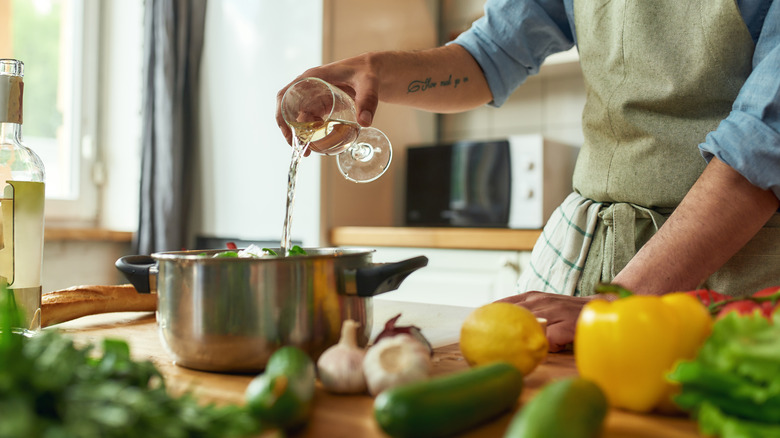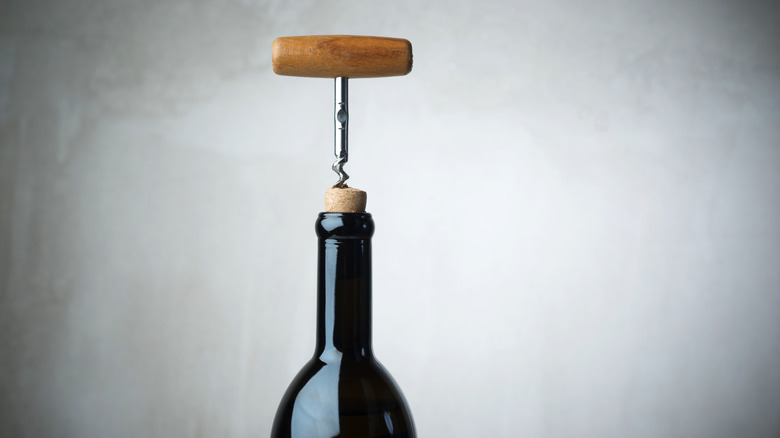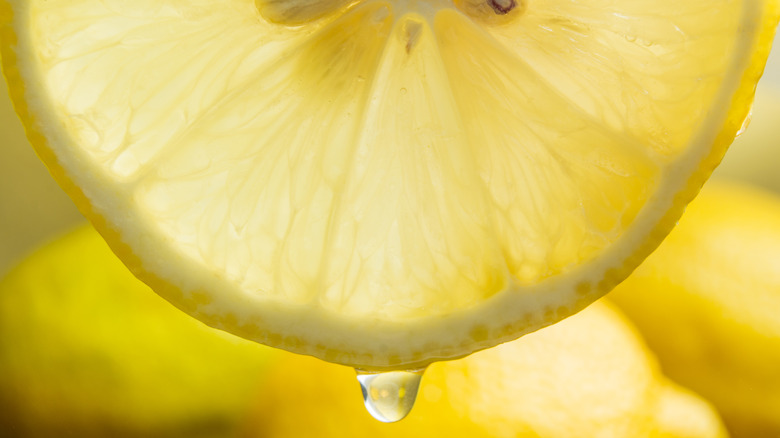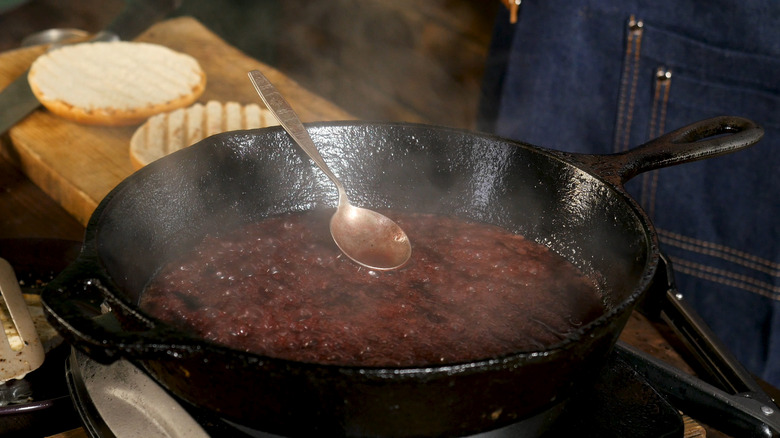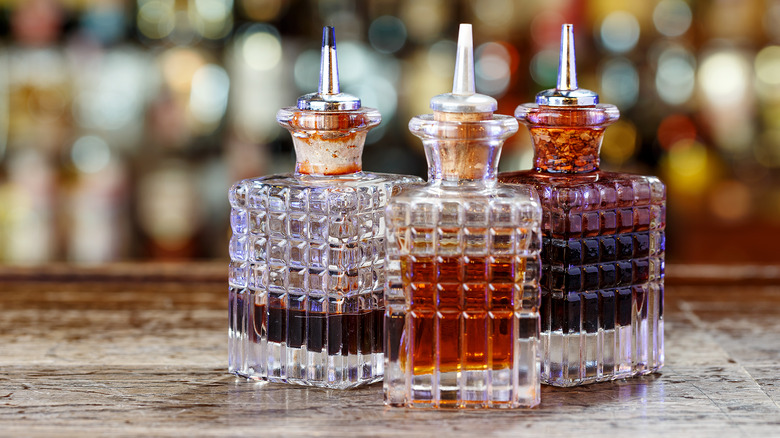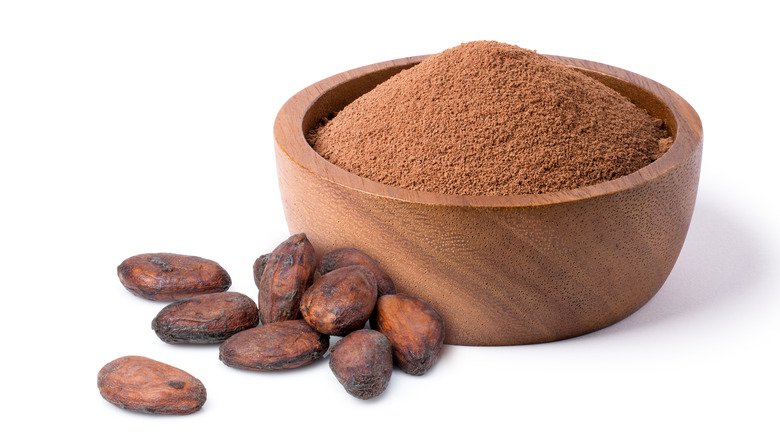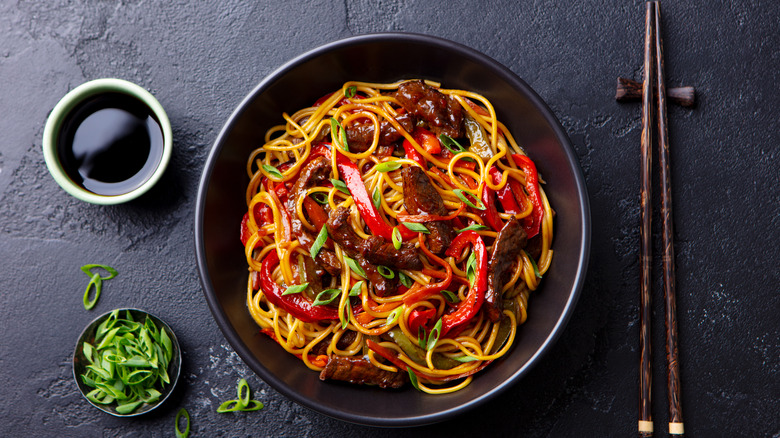Tips For Cooking With Non-Alcoholic Wine
Whether you're participating in Dry January or steering clear of alcohol for another reason, you might be considering turning to non-alcoholic wine as a beverage option. There are plenty of good non-alcoholic wines out there. But what about cooking with them? Can you get the same depth of flavor that you'd get with a regular wine? The short answer is ... yes, mostly. With a few tweaks, perhaps. Before we get into the details, let's take a look at what non-alcoholic (NA) wines are and how they're made.
Non-alcoholic wine is made using a similar process to regular wine, with a few key differences. First, the grapes are harvested and crushed to extract the juice, just as in regular wine-making. The juice is then fermented, during which time the yeast converts the sugar in the juice into alcohol. At this point, most winemakers use what's known as the "spinning cone" method, heating the fermented wine and then sending it through a long, spinning cone, which removes the alcohol via centrifugal force, according to Smithsonian Magazine.
This process can affect the mouthfeel and overall flavor of the finished wine. Makers of NA wines often add ingredients such as tannins and sugar after removing the alcohol to try to regain some of the depth of flavor that can be lacking after the de-alcoholizing process.
Choose a good-quality non-alcoholic wine
As with regular wine, you'll want to be sure you're using a good-quality non-alcoholic wine in your cooking. The standard advice of only cooking with a wine that you'd enjoy drinking is true for any type of wine, including non-alcoholic wine. A good first step to finding the best non-alcoholic wine is to research. Read reviews and ask for recommendations from friends and family.
There are a few things to consider when choosing a good non-alcoholic wine. For starters, look for a wine that has undergone the fermentation process to completion: Non-alcoholic wines that are made by halting fermentation early may have a less complex flavor profile, as the yeast has not had a chance to fully convert the sugar into alcohol.
It's also vital to consider the grape variety. Different grape varieties have different flavor profiles, so choose a non-alcoholic wine made from grapes that you enjoy. While checking out the grape variety, it's also a good idea to check the label for added sweeteners, since some non-alcoholic wines have added sweeteners to make up for the lack of alcohol, which can affect the taste (via Wirecutter). Ultimately, a lot of your selection process will come down to experimentation. Non-alcoholic wines can vary widely in flavor and quality, so don't be afraid to try a few different brands or types to find one that you like.
Open the bottle well in advance to let it mellow
What happens if you choose a non-alcoholic wine you don't love, though? Sometimes, the flavor can just be a bit too much, overpowering the rest of the ingredients in your recipe. If you're concerned that the wine you're using might be too pungent, give it some time to breathe. Open the bottle a day, or even three days in advance, recommends Some Good Clean Fun. Doing this allows some of the compounds in the wine to dissipate, and you're left with a milder wine that will play better with the other flavors in your dish.
If you're short on time, or forget to open the bottle well in advance, even a small amount of breathing time will help. You can help the process along a little by decanting the NA wine into another container, which exposes it to more air and aerates it at the same time (via Orange Coast Winery).
Cut the sweetness with pantry staples
If the non-alcoholic wine you're cooking with seems a bit too sweet for the dish you plan to use it in (you should taste any wine before you cook with it, non-alcoholic or not) there are a few ways to doctor it up to balance the sweetness and keep it from throwing off the overall flavor of your dish.
If you are using the wine in a recipe that calls for sugar, you can try reducing the amount of sugar you use. This will help to balance out the sweetness of the wine. You can also add acidic ingredients, such as wine vinegar or lemon juice, according to Cook's Illustrated, which can help to counterbalance the sweetness of the wine. Be sure to taste as you go and add the acidic ingredients gradually, as you don't want to overpower the flavor of the dish.
You could also try adding bitterness; ingredients like coffee or herbs like rosemary can help to add bitterness to a dish, balancing out the sweetness of the wine. If the wine is too dry or tannic, adding a small amount of sweetener (such as sugar or honey) can help to balance out the flavors. Again, be sure to use a small amount and taste as you go, as you don't want to make the wine too sweet. The same goes for adding a flavor enhancer such as fruit juice, fruit liqueur, or citrus zest to add depth and complexity to the wine.
Reduce at a lower temp to compensate for the lack of alcohol
Anyone who's made a pan sauce knows about the importance of reducing. Reducing a sauce also helps to thicken it, as the liquid in the sauce evaporates, leaving behind the solids. This can be particularly useful if you are trying to create a thick, flavorful sauce to serve over meat or vegetables. And a popular way of making pan sauces is to add wine and then reduce it for a super-flavorful end product.
If you're used to cooking with wine, you'll want to keep in mind that the process for reducing a non-alcoholic wine is a bit different. Alcohol has a lower boiling point than water, so sauces with standard wine are reduced at a lower temperature. Some cooks advise reducing sauces made with non-alcoholic wine at a higher temperature, since you won't have to compensate for the lower boiling point issue.
On the other hand, reducing a sauce at a lower temperature allows more time for the flavors of the non-alcoholic wine to meld with the other ingredients in the sauce more slowly and evenly (via Some Good Clean Fun). This can result in a more balanced and flavorful sauce, and since the point of this reduction isn't to cook off the alcohol, as it is in many reductions with wine, you can find the method that results in the flavor you like best.
Doctor it up with non-alcoholic bitters
Bitters are made from a blend of herbs, spices, and other botanical ingredients. They are typically used in small amounts as a flavor enhancer in cocktails and other mixed drinks. Just as non-alcoholic wine is a thing, you can also find or make non-alcoholic bitters, which add depth and complexity to the flavor of the wine and can help to balance out any sweetness or bitterness (via Yours).
It is important to use bitters sparingly, as they are very concentrated and can easily overpower other flavors if used in excess. Start with just a few drops and adjust to taste. To make the most of bitters, you'll want to choose a flavor profile that will accentuate the dish you're using it in.
If you're the DIY type (and patient!) you can also make a version of non-alcoholic bitters at home. Non-alcoholic bitters can be made by infusing a blend of herbs, spices, and other botanical ingredients in a non-alcoholic base, such as water, fruit juice, or herbal tea, depending on the desired flavor profile.
Mimic red wine's depth of flavor by adding cocoa powder
Cocoa powder can be added to non-alcoholic red wine in cooking to mimic the taste of red wine, according to AlcoholFree.com. The flavor of cocoa powder is not a perfect match for red wine, but it can help to add a similar depth and complexity to a dish.
To use cocoa powder to mimic the taste of red wine, you can simply add a small amount of cocoa to the recipe. Start with a tiny amount and adjust to taste, as cocoa powder can be quite strong and can easily overpower the flavors of the dish if used in excess.
It is important to note that using cocoa powder to mimic the taste of red wine is just a suggestion, and the effectiveness will depend on the specific recipe and your own personal preferences. You may find that the cocoa powder does not add the desired depth of flavor to your dish, in which case you may want to try a different technique.
Make the most of it by using it in spicy dishes
Because non-alcoholic wines tend to be sweeter than their regular, alcoholic counterparts, as noted by All the Bitter, consider using them in spicy dishes. Sweetness augments spiciness, so this is a great pairing. Using non-alcoholic wines in spicy dishes can help to balance out the heat and add a complementary sweetness to the dish, helping to round out the flavors.
Non-alcoholic wines can also help to enhance the sweetness of certain ingredients in the dish, such as fruit or vegetables. For example, using a NA red wine in a stew with sweet potatoes or carrots can help to bring out the natural sweetness of the vegetables.
As with many aspects of cooking, using non-alcoholic wines in your cooking is part art and part science. Experiment to find the NA wines you like to cook with best, playing with flavor combinations along the way.
